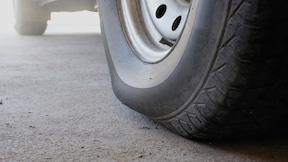Dead car battery: What now?

Quick insights
- Understanding how car batteries work can help you identify the signs of a dead battery.
- There are several causes for a car battery to die, including leaving lights on, extreme temperatures and old age.
- Knowing what to do when your car battery dies can save you time and money by enabling you to quickly troubleshoot or address the issue, potentially avoiding the cost of towing and professional service fees.
There are few car problems that require more immediate attention than a dead battery. Imagine this: you're all packed up for vacation and ready to hit the road, but your car won’t start. If a dead battery is the culprit, we've got some solutions.
Car battery basics
Understanding the basics of how car batteries work can help you better maintain your vehicle and identify potential issues.
- Energy storage: Car batteries store chemical energy and convert it into electrical energy. This energy is what powers your car's electrical systems.
- Starting the car: The battery provides the initial power to start the engine. Without a functioning battery, your car won't start.
- Powering electrical components: Once the car is running, the battery powers the electrical components like lights and radio. If your battery is weak, these components may not function properly.
Knowing these fundamentals can help you spot when your battery might be nearing the end of its life.
What causes car batteries to die?
Several factors can lead to a car battery dying. Being aware of these can help you prevent premature battery death.
- Leaving lights on: Leaving your headlights or interior lights on can drain the battery. Do your best to remember to turn off your lights when you exit your vehicle.
- Extreme temperatures: Both hot and cold temperatures can affect your battery's performance. Extreme temperatures can cause your battery to work harder, which can shorten its lifespan.
- Old age: Most car batteries last between 3 to 5 years. After this period, they are more likely to fail. Regularly check your battery's health, especially if it's older.
- Corrosion: Corrosion on the battery terminals can impede the flow of electricity, making it harder for your car to start. This buildup typically appears as a white, ashy substance on the metal parts of your battery. Regularly cleaning the terminals with a solution of baking soda and water can help maintain good connectivity and extend the life of your battery.
- Inactivity: Even when your car is turned off, the battery is still working to power electronic systems. When you don’t turn your car on, the alternator isn’t doing its job of converting mechanical energy from the engine into electrical energy to recharge the battery. Make sure you are regularly using your vehicle or disconnecting the battery if you won't be using the car for an extended period of time.
By keeping these factors in mind, you can take steps to prolong the life of your car battery.
How to tell if your car battery is dead
Identifying a dead car battery is crucial for timely maintenance and avoiding being stranded. Here are some key indicators and steps to determine if your battery is the issue:
- Slow engine crank: When you attempt to start the vehicle, the cranking of the engine is sluggish and takes longer than normal to start.
- Headlights and electronics: If your headlights or interior lights are dimmer than usual, or if electronic components like the radio or power windows are operating slower than normal, it could indicate a weak battery.
- Dashboard warning light: Many cars have a battery warning light on the dashboard that illuminates when there is an issue with the battery or the charging system.
- Battery voltage: Using a multimeter, you can check the voltage level of your battery. A healthy battery should have a voltage between 12.4 and 12.7 volts when the car is off. Anything lower suggests the battery is weak or dead.
- Age of the battery: Consider the age of your battery. If it's close to or beyond the typical lifespan of 3 to 5 years, it might simply be time for a replacement.
- Inspect for corrosion: Look for any signs of corrosion on the battery terminals, as this can cause poor conductivity and battery failure. Cleaning the terminals may restore proper function.
- Listen for clicking sounds: When trying to start the car, listen for a clicking sound. This often indicates that the battery does not have enough power to turn over the engine.
By recognizing these signs and performing these checks, you can more accurately determine if your car battery is dead and take appropriate action to address the issue.
What to do if your car battery dies
If your car battery dies, there are several options for addressing the situation, both in the short-term and long-term.
Short-term solutions to a dead battery
When you're in a pinch, there are a few short-term solutions that can help you deal with a dead car battery.
- Jumpstart the battery: Using jumper cables and another car, you can try to jumpstart your dead car battery. This can provide enough power to start your car and get you to a location where you can replace the battery.
- Recharge the battery on your own: Portable jump starters can jumpstart your car without needing another vehicle. Battery chargers can also recharge your battery, but they require access to a power outlet.
- Call for roadside assistance: If you're unable to jumpstart the battery, you may need to call for professional help. Roadside assistance can provide a jumpstart or tow your vehicle to a repair shop.
These short-term solutions can help you get back on the road quickly, but they aren’t likely to solve the underlying problems with your battery in the long-term.
Long-term solutions to a dead battery
The best long-term solution to a dead battery is prevention. Regularly checking your battery's health can help prevent unexpected failures. Here are some ways you can help maintain your battery’s health:
- Regular inspections: Regularly inspect your battery for any signs of damage or wear. Look for cracks in the casing, corrosion on the terminals or bulging sides. These could indicate a problem with your battery.
- Clean the terminals: Over time, corrosion can build up on the battery terminals, which can affect the battery's performance. Cleaning the terminals regularly with a brush and a mixture of baking soda and water can help maintain a good connection.
- Use a battery tester: A battery tester assesses your battery's charge and overall health by measuring its voltage output, capacity and resistance. This can give you an idea of your battery's health and let you know if it's time for a replacement.
If your battery is damaged, old or frequently requires a jump start, it may be time for a replacement. A new battery can provide reliable power and prevent future breakdowns.
What to do with a dead car battery
When it's time to say goodbye to your old battery, remember to dispose of it responsibly. Many auto parts stores and recycling centers accept old car batteries. Some stores may offer a discount on a new battery when you trade in your old one.
The bottom line
Understanding how your car battery works and what causes it to die can help you prevent unexpected failures. If your battery does die, knowing what to do can save you time and money. Remember to recycle your old battery responsibly when it's time for a replacement.



